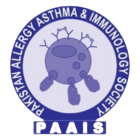The Only Patch Test Clinic In Pakistan
Latest Patch Tests Done With World No.1 Patch Test Kits
Patch Test Clinic
Message From Dr Shahid, Consultant Allergy and Immunology
Thank you for choosing the Patch Test Clinic at Allergy and Asthma Center. We have provided an informational packet for what to expect at your time of visit as well as a questionnaire to help us coordinate your care. ALLERGY And ASTHMA CENTER, Al Rehman Chambers, Fazal e Haque Road Blue Area, Islamabad , Pakistan
A map is enclosed for your convenience. Should you have any questions please do not hesitate to contact our office at , +92 51 111 160 160.
Sincerely,
Dr Shahid Abbas
FAAAAI (Fellow American Academy of Allergy Asthma and Immunology)
Consultant Allergy & Immunology
ALLERGY And ASTHMA CENTER
DUE TO COVID:
- We ask you to bring your mask. It is mandatory to wear your mask during your visit.
- Please call us at 051-111-160160 upon your arrival and we will instruct you on when to come in.

We are pioneers and unique in doing practice of Patch testing
Dr Shahid was trained in Patch Testing in USA, He had a training Seminar and workshop on Patch Testing with the collaboration of Agha Khan University & Hospital and Pakistan Association of Dermatologists in March 2020.
Allergy Patch Testing
Everything you need to know
We can test for hundreds of contact allergens and customize each patient’s patch tests based on their likely exposures and personal skin care products. In addition to identifying contact allergies and providing a list of products to avoid, we also provide customized lists of skin products that are safe to use. Regardless of the patch testing results, we will make recommendations for optimizing our patients’ skincare and treatment plans
Patch testing helps to determine if patients have allergies to things that touch their skin, such as ingredients in skin care products, botanicals, fabrics, metals, sunscreens, and other chemicals. These ingredients may be found in patients’ skin care products or in materials they are exposed to at home, at work, or when they participate in their favorite hobbies.
After the Patch Tests in addition to identifying contact allergies and providing a list of products to avoid, we also provide customized lists of skin products that are safe to use. Regardless of the patch testing results, we will make recommendations for optimizing our patients’ skin care and treatment plans.
Patch testing is a process that detects allergic contact dermatitis, and involves applied patches with testing samples to the back. Using tape, these patches with test substances are left on the back for a small amount of time to see if a dermal reaction occurs. This is a proven process that shows accurate results for many individuals, and the test substances applied are determined by your allergist. The patch test does not test for food allergies, but can test for other allergies that cause dermal reactions, such as nickel, fragrances, and preservatives.
CHECKLIST FOR PATCH TESTING
- If you have prior patch testing results or skin biopsy reports, please bring those with you.
- Bring all Products used in area of rash over the past 3 months.
- Wear an old, dark T-shirt to visit (for young kids, it is a good idea to wear a T-shirt that is 1-2 sizes too small to help keep the patches snuggly in place).
- No tanning on your back 2-3 weeks prior to visit.
- No STEROIDS by mouth 1 week prior to visit. No topical STEROID creams to back for 3 weeks prior to visit (everywhere else is ok).
- No topicals of any kind on your back on the Day of your visit.
- Please shave your back if it is hairy.
- Once patches are applied, there is no reaching, stretching. or pulling. Patches must remain in contact with your back for 48 hours.
- Refer to MAP for our location.
- Plan to be at our clinic for two hours.
- Once you have read through your packet and gone through your checklist if you have any additional questions, please call the office.
- PLEASE come prepared as you want your testing to be complete and you only want to do it once
Latest Patch Tests Done With World No.1 Patch Test Kits
YOU MAY HAVE CONTACT DERMATITIS AND NEED PATCH
- You can have rashes in different parts of the body away from the contact part e.g you may have rashes on your legs due to an allergy to jewelry.
- Your rashes eczema clears or improves during holidays, and relapses after you are coming back to your home or work.
Your rashes/eczema is mainly located on the hands, around the eyes, or in the genital area. - Your dermatitis/eczema lasts longer than 3 months; even if another diagnosis was already established (other chronic inflammatory diseases of the skin may enable the penetration of sensitizers and promote sensitization).
How long does a patch test take and what is involved ?
The length of time for the patch test may vary depending on what allergens you are getting patch tested for. Because dermal allergic reactions can take some time to show up on the skin, patch testing can involve multiple visits to the clinic for a week, in order to apply the patches, and then test for the reactions.
Day 0……..Patch test application
Day 2……..Patch Test Removal (Initial Reading)
Day ¾……Main Reading
Normally it takes 3-4 days but one should again visit on day 7
Skin Allergies
An allergic skin condition (skin allergy) is when an allergen (a substance that causes an allergic reaction) triggers an immune system response, resulting in irritated skin. Many times, patients suffer from skin allergies for years before receiving a diagnosis.
Common products that cause skin allergies may include:
- Nickel and metal products
- Fragrances
- Preservatives
- Rubber products
- Hair dyes
- Plants
- Skin care products
Contact Allergy and Allergic Contact Dermatitis (ACD)
Contact allergy is the result of specific immune responses caused by antigens. Unlike allergens (such as pollens and animal proteins) causing other forms of allergy, the culprits of Contact Allergies, haptens, are not antigens by themselves. Haptens (typically small, chemically reactive molecules with low molecular weight) need to penetrate the horny layer of the skin in order to conjugate to epidermal and dermal proteins forming “hapten-carrier complexes” with antigenic properties capable of causing contact allergy. Examples of widely recognized haptens include nickel, formaldehyde and preservatives in cosmetics.
- Contact allergy is the state of being sensitized to a hapten. Sensitization to a hapten occurs when the accumulated exposure to that specific hapten surpasses a certain threshold. This threshold is individual and varies greatly between different persons. Some will develop an allergy the first time encountering a hapten, others withstand a life time of exposure without becoming sensitized.
- Allergic Contact Dermatitis (ACD) is a disease of the skin that emerges in people that are exposed to specific haptens after having developed contact allergy. Once allergic, the subject will respond with skin inflammation (redness, flaking skin or blisters) whenever exposed. Individuals handling haptens as part of their profession run a higher risk of developing ACD. ACD accounts for 20% of all reported work related skin diseases. Occupational fields with high occurrences of ACD include (but are not limited to) hairdressing, construction work, cleaning and health care. Chronic once developed, and with no known cure, contact allergy is of major distress for those affected.
Diagnosis
While contact allergy cannot be treated it can be diagnosed; by Patch Testing and not by Skin Allergy Testing (such as skin prick testing – used for the diagnosis of i.e respiratory allergies). Knowing what hapten is causing the allergic reactions helps the patient stay clear of that specific hapten, avoiding ACD and thereby effectively improving the quality of life for the individual.
Diagnosing a skin allergy
To confirm a diagnosis of contact dermatitis, we will first ask you about your medical history, occupation and symptoms. To help us during the diagnosis:
- Take note of when your symptoms appear, get worse or improve
- Take note where the symptoms occur on your body
- Describe your work in detail to your doctor, because workers in certain occupations are more likely to develop contact dermatitis
- If you handle chemicals, make a list of these or find their Material Safety Data Sheets (MSDS)
Patch testing for diagnosing skin allergies
We use patch testing to determine what contactants (substances that cause a contact allergy) are causing your allergic reaction. To perform a patch test, we place a number of different allergens on the skin of your back and check for an allergic response. This is not the same as prick testing. Talk to our allergists to decide if patch testing is appropriate for you.
We determine which allergens to check for based on your:
- Hobbies
- Occupation
- Daily routine















